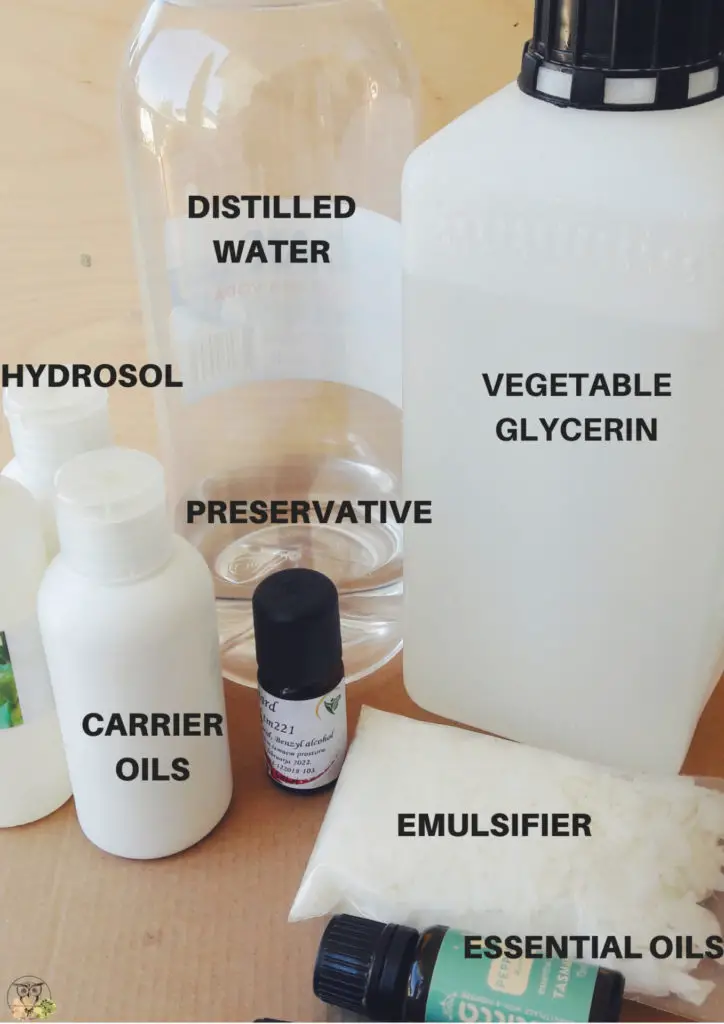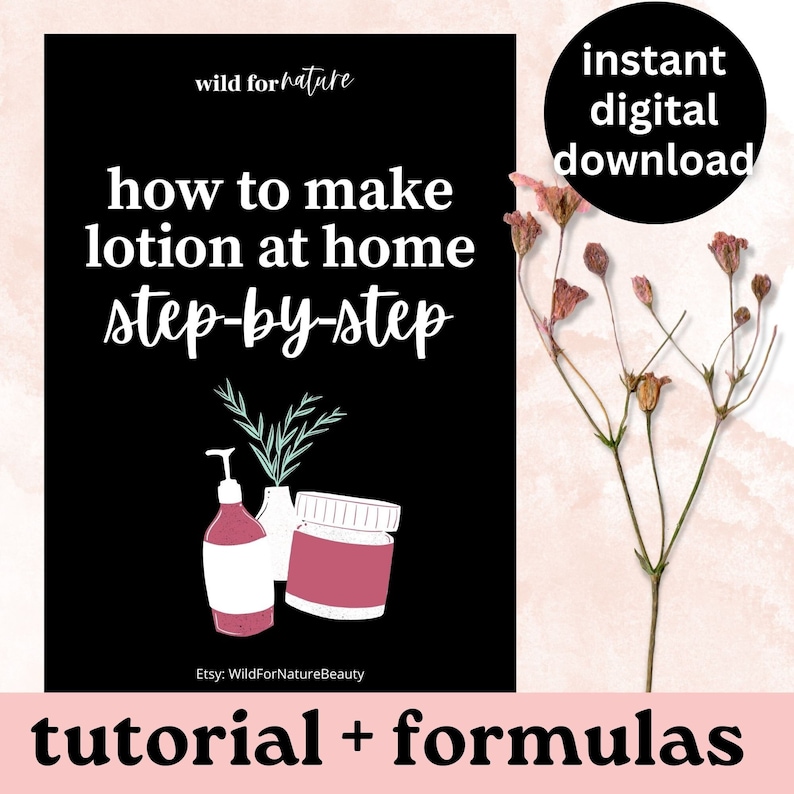Hello, my lovely DIYers! Today I have a guide for you; we’re getting into homemade lotion, we’re taking it one step at the time and I’ll show you the entire process and all equipment that you need.
Just recently it was pointed out to me by one of our regulars, Mara (thank you!), that we have lotion formulations on the blog and articles about ingredients that can do wonders for your skin, but there are no guides on how to combine all that into a lotion/cream!
So, it’s a high time for a detailed guide here. Now, let’s get to it. I’ll take you through the entire process of how to make lotion at home. It will seem a bit much at first, but it’s not as complicated as it seems. Promise!
Let’s get one thing clear: the following method can be used to formulate all types of lotions; as soon as you’re combining water with oil, this method is what you need. With this method, you can make:
- All sorts of body lotions, moisturizers, and creams
- All sorts of facial moisturizers (such as gentle lightweight one), serums, skin creams that target specific problems
- Hair conditioners and masks
- Hand and foot creams
- Lotions/creams that target a specific area of the body
Want to master lotion & cream making? Learn how to formulate lotions independently from scratch with my detailed guide to lotion making. Beginner-friendly, super detailed, with 3 different formulations and 2 variations. Bonus! Formulation worksheet.
1. Know this before you begin
Before you begin gathering ingredients and cooking up your DIY lotion, focus on the following:
- Think about the recipe: what do you want your cream to do?
- Gather your equipment
- Clean and disinfect your equipment
- Prepare and disinfect your working area
2. Equipment you need
Here’s what I use every time I make a facial cream or a body lotion:
- 2 heat-resistant glass beakers
- A 0.01g scale
- A silicone spatula
- Immersion blender
- A thermometer
3. A word about a scale and why it matters
The scale is more important than you may think. You need to know the exact amount of ingredients you’re using or the final products can result in a mess. You can’t expect a successful final result if you add ingredients in tablespoons and ounces. Formulating requires precision and all ingredients, from distilled water to preservative play a role in your recipe. It’s important for them to be added in the correct amounts every time you make something.
4. Gather your ingredients
Before you begin whipping anything up, think about your lotion-to-be: what’s its purpose? What do you want it to target?
Do you want to make a light facial moisturizer? A light body lotion? Cream for dark circles? An easy hair mask or a nourishing hand cream?
Before you start formulating, do your research. Into the recipe, include the ingredients that will all work together to improve whatever you’re trying to soothe, heal, or hydrate.
Preservatives
I’ve extensively talked about preservatives and why to use them here. But in short, preservatives are a must in water based recipes. They help to prolong the shelf-life of a product and keep all the nasty organisms out of your lovely facial creams.
Emulsifiers
Okay, emulsifiers are a good reason in DIY skincare to give anyone a headache especially when you’re first starting out. You can read an article from Formula Botanica on how to choose the right one.
Emulsifiers are basically agents that help to combine water with oil. You know that oil and water don’t naturally mix with one another. So, think of emulsifiers as “glue” or negotiators that help to smooth things out and make it all work well.
5. Understand how it’s done and write it down
First of all, when you write a recipe, this is how you do it:
Firstly, the amount of ingredients used has to come up to 100.
Secondly, you have to know about the three phases of formulating. Think of it this way: when you list all the ingredients, separate them between the following three “stages” based on their properties:
1st phase: water phase
(this is where you list all your water-based ingredients. In other words, here, list all the ingredients that are soluble in water)
You can find out whether an ingredient is water-soluble by checking the info sheet from a supplier. If it says water-soluble, it can be used in this phase.
2nd phase: oil phase
(this is where you list all your oil-based ingredients. All ingredients that dissolve in oil fall into this phase)
You can find out whether an ingredient is oil soluble by checking the info sheet from a supplier. If it says oil-soluble, it can be used in this phase
3rd phase: cool-down phase
(there are ingredients that are heat sensitive. These always go into the last, cool-down phase of your formulation. When making an emulsion, you wait for it to cool down to 40 degrees or less before you add any heat-sensitive ingredients.)
6. An example: body lotion formulation
Now, let’s combine all that you’ve learned so far. Here I’ve prepared a basic DIY lotion recipe to give you an idea on how and why and when.

Remember, we want to stick to a magic number of 100 when designing a recipe! So here we go. For a 100g body lotion we’d need:
Water phase (83%)
- 50.6g Distilled water
- 30g Peppermint hydrosol
- 2g Vegetable glycerin
- 0.4g xanthan gum
Oil phase (16%)
- 5g Emulsifier (Olivem1000)
- 5g Mango butter
- 6g Grapeseed oil
Cooldown phase (1%)
- 0.5g Preservative (Cosgard)
- 0.5g Essential oils (half lemongrass and half cedarwood)
7. How to make lotion from scratch: a photo guide
- Gather your equipment, disinfect it, prepare and clean your working area
- Take another heat-resistant cup and do the same with oil-based ingredients (you don’t have to weigh anything after, these won’t evaporate!)
- Place both beakers into the pan
- Wait 15-20 minutes for all the ingredients to fully melt
- In the meantime, prepare your hand blender and ingredients that you’ll include in the final phase
- Remove both beakers from the pan; gently wipe them with a clean cloth
- Pour water-based mixture into the oil mixture and begin mixing
- With a hand mixer, mix for 2 to 5 minutes
- Let the emulsion cool down to 40C (this may take up to 30 or more minutes, depending on the amount of cream you’re making)
- Once cool, add all ingredients (apart from a preservative) and whisk the emulsion well
- Add preservative, stir well
- Transform your cream/lotion into a container
And there you go! You’ve just made your first lotion from scratch! How do you feel about that? It’s pretty awesome, right!
Hopefully, you’ll find this guide helpful enough! Feel free to leave comments below. If you make anything Wild-for-Nature based, post to Instagram and tag! We want to spread our #wildfordiy!
Help support Wild for Nature
Many of you have asked if there’s a way to help support Wild for Nature. I’ve signed up for Buy Me Coffee. If you love what I do, learn from me, sell anything you made from my recipes, and want to see Wild for Nature grow even more, I’d be thrilled if you’d consider buying me a coffee! It works as a one-time or a monthly donation of $3. You can also get beautifully designed PDFs with a series of recipes and other resources I publish there, to help you learn and get creative at home! I can then use that money to further develop and grow Wild for Nature and you can help me continue with wild creations and resources!


[…] drying your skin with so many washings per day, you can actually make acne worse by irritating and DIY Skincare becoming dry your sensitive skin. Instead opt at least in the morning, once in manufactured and […]